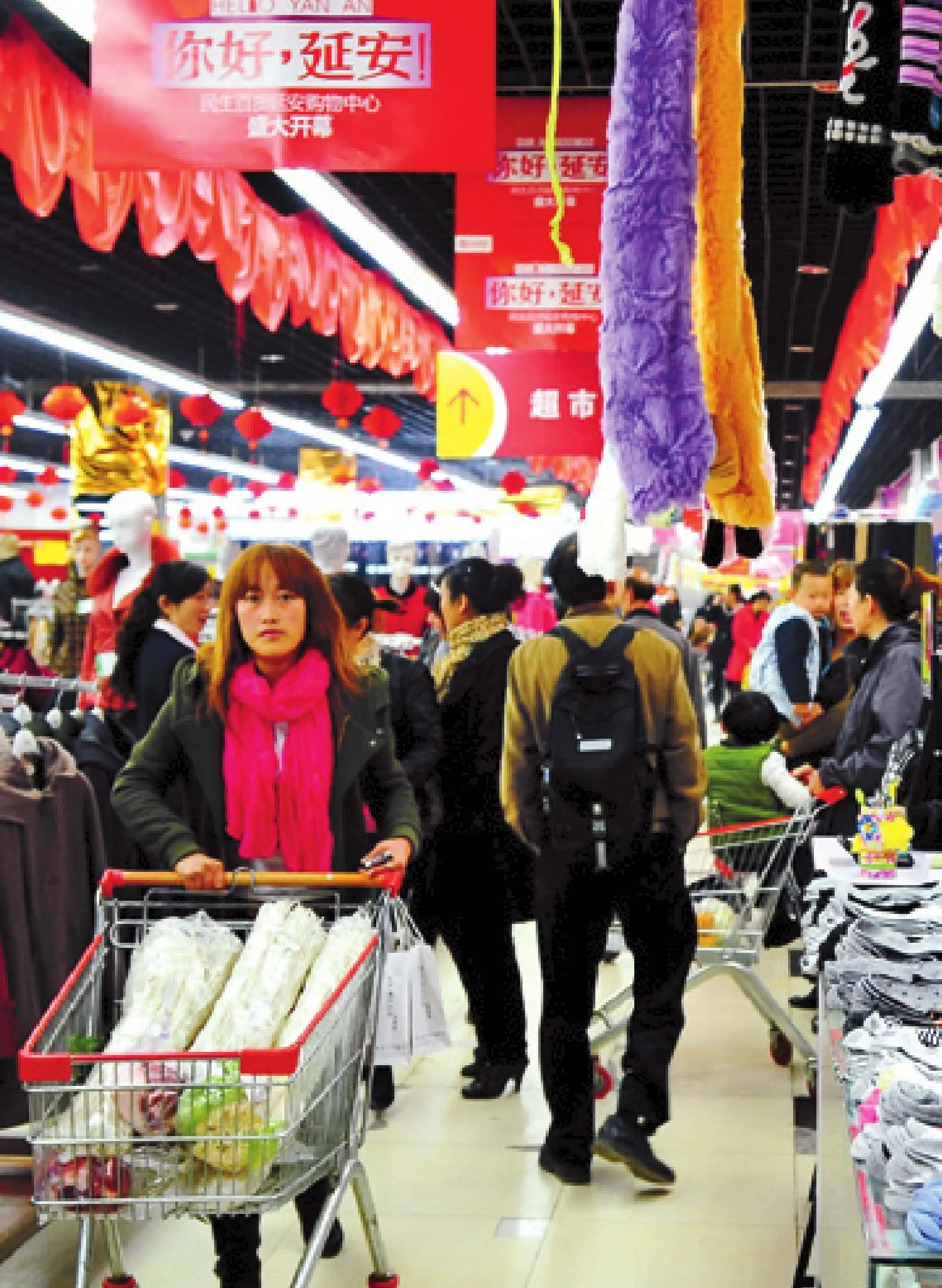Sustaining Consumption
2012-10-16ByLanXinzhen
By Lan Xinzhen
Sustaining Consumption
By Lan Xinzhen
Boosting domestic demand, especially consum ption, has become a viable engine for China’s econom ic grow th
T he China Tex tile Comm erce Association is busy preparing for the Beijing Women’s Shopping Festival this May. The commodity fair, aimed almost exclusively at female shoppers, w ill feature a w ide array of dresses, bags, luggage, shoes,hats and various other accessories.
The Beijing shopping festival is just one of almost 70 promotional events being organized by the M inistry of Commerce to promote domestic consumption in 2012. The diversified portfolio includes China International Beer Festival in Dalian in July, the Ninth China International Gourmet and Travel Festival in Chengdu this September and China Silk Fashion Festival in Beijing this July.
The ministry also announced plans for a 2012 consumption promotion month between April 2 and May 4 to coincide with the Tomb Sweeping Day and Labor Day holidays.
According to M inister of Commerce Chen Dem ing, spurring domestic demand,especially domestic consumption, is fundamental to driving the country’s steady and rapid economic grow th, especially as overseas demand wanes and a high investment rate becomes unsustainable.
A fter the global econom ic recession occurred in 2008, the Chinese Government unveiled a series of subsidies and tax rebates to encourage domestic consumption of household appliances and cars to replace older models w ith new ones. That program ended in 2011.
This year China w ill continue the subsidy program for rural appliance purchases. The Central Government will also launch a series of policies to boost consumption.The new policies will focus on promoting projects in the green economy, low-carbon emissions,energy-conservation and environment protection, said Chen.
Chen also pointed out that soaring logistics costs in the past two years were blamed for consumer goods price hikes.The State Council has decided to clear up arbitrary charges in logistics to lower prices and improve the environment for consumers, said Chen.
Eyes on the p rize
The giant Chinese market w ill surely become a target international businesses cannot afford to miss. During the Third Novo Mania Fashion Trade Show held in Shanghai on March 7-9, a slew of European fashion brands signed dealership contract w ith Chinese agents, including Lotto, Puma and Elle. As a result of falling textile and clothing demand in the United States and the European Union, more and more international fashion brands have begun to make inroads into the Chinese market.
According to the PwC 15th Annual Global CEO Survey issued on March 15, with no signs of a pickup in the euro zone and U.S. economies,strong expectations are being placed on China for grow th opportunities. Globally, 30 percent of global CEOs rank China as their top grow th market in the next 12 months.
David W u, Pw C China Beijing Lead Partner, said that the Chinese economy may be slow ing down, but the China story remains attractive and critical to global CEOs’ grow th strategy. China may have lowered its grow th rate to 7.5 percent for this year, but that projection is still more than double the grow th rate of the global economy.
While foreign companies spare no efforts in increasing their presence in China, local enterprises surely have more know-how in acquiring and holding on to market share. This April, Suning Appliance Co. Ltd., one of China’s biggest privately owned electrical appliance retailers, w ill launch a more convenient installment payment scheme for home appliance purchases featuring “zero down payment, zero interest rate and zero commission.”
Suning started its credit consumption of home appliances in 2008, and currently credit consumption accounts for 20 percent of its total sales volume.
LIU XIAO

BUSY LANES:Consumers shop in a departm ent store in Yan’an, northwest China’s Shaanxi Province
Consum er Market Pro jection
By 2015, China’s total retail sales of consumer goods are expected to reach 32 trillion yuan ($5.08 trillion), an average annual grow th of 15 percent; total added value of lodging and catering w ill reach 8.6 trillion yuan ($1.37 trillion), an average annual grow th of 15 percent; total retail online sales w ill reach 2 trillion yuan ($317.46 billion), an average annual grow th of more than 30 percent; and final consumption sales w ill reach 35 trillion yuan ($5.56 trillion), an average annual grow th of 13 percent and an ultimate consumption rate of 50 percent.
(Source:Ministry of Commerce)
“We hope to promote the grow th of credit consumption w ith the launch of new projects,”said Wu Enlong, General Manager of the Beijing Branch of Suning Appliance Co. Ltd.
As a matter of fact, China’s rapid econom ic grow th has become a magnet luring international enterprises to the Chinese market. A recent report released by the American Chamber of Commerce in Shanghai and the management consulting fi rm Booz & Co. Inc.showed that China is forecasted by most analysts to become the second largest consumer market in the world by 2015, not far behind the United States, w ith enough purchasing power to buy 14 percent of the world’s products, up from 5 percent today.
In addition, a report released by the World Luxury Association said that China is on the way to replace Japan to become the world’s largest market for luxury goods.
According to a survey by the global investment banking and securities firm Goldman Sachs, China’s consumption on luxury goods w ill reach $14.6 billion in the next five years, and the number of people who are w illing to pay for luxury goods w ill exceed 100 m illion.
Zhao X ijun, Deputy Director o f the Financial and Securities Institute at the Renmin University of China, suggested that w ise entrepreneurs should seize business opportunities of the Chinese Government’s efforts to boost domestic demand. Zhao also suggested a development trend for China’s consumer market, namely, the emerging consumer market in some second-tier and thirdtiers cities.
During the National Day holiday last year, most cities that scored a year-on-year consumption increase of 20 percent were small and medium-sized cities in central and west China.
Zhao urged enterprises to be aware of the importance of e-commerce in expanding their sales. According to China E-Commerce Research Center, the country’s total e-commerce revenue reached 6 trillion yuan ($947.4 billion) in 2011, a year-on-year increase of 33 percent.
Suggestions
Despite the fact that the Chinese Government has launched a series of measures and policies to expand domestic demand in recent years,the contribution of consumption to China’s GDP grow th and the consumption level still lag far behind advanced countries.
According to Li Chang’an, associate professor at the School of Public Administration of the University of International Business and Econom ics, the root cause of China’s weak domestic demand is structural imbalance in demands.
The primary task for China to expand its domestic demand is to cultivate private investment and consumption, said Li. In the past, China relied on government investment and consumption to boost its domestic demand, and private investment and consumption were constrained.
In addition, China should complete its market and competitive mechanism w ith the least delay possible. The existence of monopolies has fragmented the market and kept barriers to market entry high. While governmental investment remains high, chances for private investment are slim. In this sense,China needs to reform its management system of state-owned enterprises to restrain their business scope and leave more space for private companies. The most important thing in encouraging private investment is creating a market environment with fair competition.
At the same time, China should accelerate its income distribution system reform and cultivate the medium-income class, said Li.Despite the fact that statistical figures showed that the grow th of incomes for urban employees outpaced that of overall GDP in the past decade, their real income and buying power have been largely eroded w ith high inflation and price surges of some major products for daily use. Furthermore, the w idening gap in income distribution has made most average people feel powerless while the rich are able to spend more on luxury goods.
“China could form its econom ic grow th mode propelled by consumption only if it could accelerate the cultivation of a largescale and stable medium-income class,” said Li.
Zhao also pointed out that the income gap has been w idening in recent years and that the government should make efforts to increase the proportion of labor income and narrow the income gap through the adjustment of the taxation system and the fiscal transfer payment system.
“Only when average people feel that they can reach a reasonable consumption level, will the country’s total consumption grow steadily and persistently,” he added.
